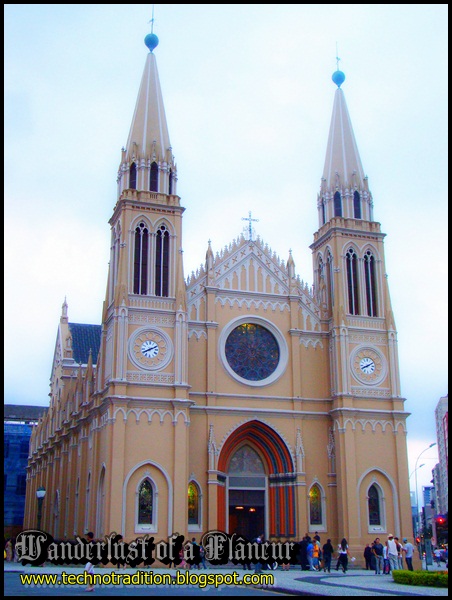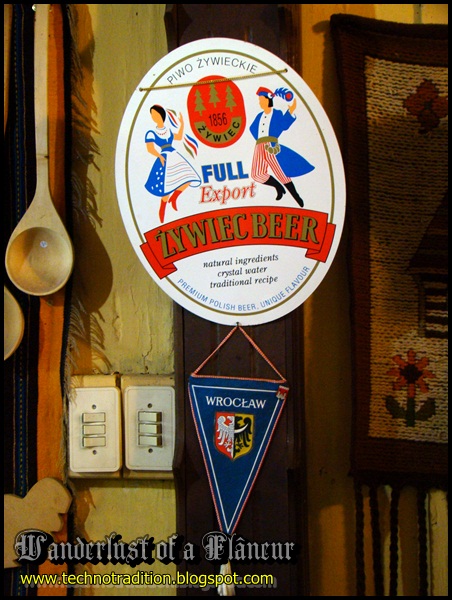The coat of arms of Curitiba was established by the municipal law No. 2993 on May 11, 1967. It is described as follows: Traditional Iberian shield, surmounted by the mural crown in gold which means Curitiba is a high level place (it's the capital of Paraná), In field sips, a silver pine tree, put in abyss. On its right side wheat stalks and on the its left a branch of tendrils. On the base there is Curitiba at the centre and on the sides the date of the foundation of Curitiba Village.
City: Curitiba
State: Paraná
Country: Brazil
GPS Coordinates
My Commentary: Curitiba honestly impressed me. It's a huge urban place but it's not as crazy as São Paulo City, somehow that was managed to keep it organised. The city is clean generally saying and there are countless places to visit, from underground to popular. Curitiba really deserves the title of capital, not only for its rich History but also because of what was resulted of it in the present.
State: Paraná
Country: Brazil
GPS Coordinates
My Commentary: Curitiba honestly impressed me. It's a huge urban place but it's not as crazy as São Paulo City, somehow that was managed to keep it organised. The city is clean generally saying and there are countless places to visit, from underground to popular. Curitiba really deserves the title of capital, not only for its rich History but also because of what was resulted of it in the present.
Interesting Facts:
- In 2015 Curitiba was placed as the most populous city of the South region of Brazil
- In 2010 Curitiba awarded the Globe Sustainable City Award
- Curitiba has the highest number of public libraries per inhabitants in Brazil.
- Curitiba is known as Cidade Modelo (model city)
- The lowest temperature registered in Curitiba was -6,5 ºC in June 15th, 1920
- The first promenade (esplanade) in Brazil was in Curitiba
- The area where today is Curitiba was for many year part of São Paulo State (until 1853)
- Curitiba had as immigrants and colonizers many Europeans of West and East and also Japanese people which was definitive to establish what today is the folk culture of Curitiba.
Free download of the e-book Curitiba Antiga by the author Eliel Nogueira (authorized download)
History of Curitiba: The first ten years of the 16th century had a war of conquest by Europeans (Portuguese colonists) against the Kaingangand Guarani who inhabited the area of the city. Curitiba's birth is 29 March 1693, when its City Council was founded. At the end of the 17th century, Curitiba's agriculture was only for subsistence. Its main economic activities were mineral extraction. Waves of European immigrants arrived after 1850, mainly Poles, Italians, Germans (mostly from Russia) and Ukrainians. In 1853, the south and southwest of the province of São Paulo were emancipated, forming the new province of Paraná with Curitiba as its capital.
The region's next economic cycle was based on the "tropeiros" ("troopers"): cattlemen who drove their herds from Viamão, in the southernmost state of Rio Grande do Sul, to a market in Sorocaba, in the state of São Paulo. From there, the herds were then taken to the state of Minas Gerais. The drovers would spend winter periods in the middle of the journey, in the "campos de Curitiba" (fields of Curitiba). These campsites would be dismantled when the cold season gave way to spring. The drovers would take advantage of their stay to do business, and by doing so, they made Curitiba into an important intermediate trading post. The traditions of wearing wool ponchos, roasting meat and drinking a bitter mate tea called "chimarrão", encouraged a common culture that led people to form groups and settle. The cycle of cattle drives lasted for more than two centuries. With it, came many distinct cultural features of the Paraná region, especially an unique accent.
The expanded use of the mate plant and wood at the end of the 19th century stimulated the construction of the Paranaguá-Curitiba railroad. This railroad was the first link between the capital of Paraná and the coast. It was built in five years (from 1880 to 1885). This railroad represents one of the greatest works of national engineering, made possible thanks to the engineers and brothers Antonio and André Rebouças. Immigrant manual labor was heavily used. Immigrants had come to this area since the middle of the 18th century.
Around the beginning of the 20th century, Curitiba benefited from the wealth of the yerba mate mills. The owners (known as"Maté Barons") built mansions in the capital. These have mostly been preserved in the districts of Batel and Alto da Glória.
The next economic cycle was the coffee monoculture. This trade helped found cities in the northern region of the state of Paraná. Coffee was important the capital's economy. Coffee crops suffered from the relentless effects of bad weather. So, farmers gradually replaced coffee by soybeans. Mechanized soybean farming drove agricultural workers off of the land. Eventually, coffee was completely wiped out in the region's worst frost, known as the Black Frost of July, 1975.
During the 20th century, especially after 1950, the city's population rapidly increased. It consolidated its position as a regional hub for trade and services, becoming one of the richest cities in the Southern Cone and a pioneer in urban solutions. In the 1940s and 1950s, Alfred Agache, co-founder of the French Society for Urban Studies, was hired to produce its first city plan. It emphasized a "star" of boulevards, with public amenities downtown, an industrial district and sanitation. It was followed in part, but the plan was too expensive to complete.
When Curitiba received great waves of immigrants, the city was forced to make swift decisions in order to avoid urban chaos and meet future demands. Curitiba invested in urban planning and in city management focused on its residents. (Wikipedia
Anthem of Curitiba:
Lyrics: Ciro Silva
Melody: Bento Mossorunga
On the same day of the establishment of the coat of arms and flag of Curitiba, this anthem was also set official. (May 11th 1967).
Melody: Bento Mossorunga
On the same day of the establishment of the coat of arms and flag of Curitiba, this anthem was also set official. (May 11th 1967).
Cidade linda e amorosa da terra de Guairacá.
Jardim luz, cheio de rosa Capital do Paraná.
Pela ridente paisagem
Pela riqueza que encerra,
Curitiba tem a imagem
Dum paraíso na terra.
Viver n’ela é um privilégio
Que goza quem n’ela está.
Jardim luz, cheio de rosa
Capital do Paraná.
Pérola deste planalto
Toda faceira e bonita.
Na riqueza e na opulência
Vive, resplande, palpita
Subindo pela colina
Altiva sempre será.
Jardim luz cheio de rosa
Coração do Paraná.
Salve! cidade querida
Glória de heróis fundadores.
Curitiba, linda jóia
Feita de luz e de flores.
Original video by GuardaDouglas
My Photos in Curitiba - Trip 2014
My Commentary: I will sum it for now, after about 10 years without visiting our little house in Ilha Comprida, I finally went there with my family. Once there I had the ambitious idea of visiting my friends in the South of Brazil, since Ilha Comprida is in the South of São Paulo. At the end the plan worked better than I thought and I visited many places going by bus and then returning from the extreme South to my town by air plane. The list above follows the sequence of the route I did. It's possible to click in all the towns and get information and photos:
São Paulo
Paraná
Santa Catarina
Rio Grande do Sul
Here below there is a picture with some stuff I brought from all the places I visited.
My Photos in Curitiba - Trip 2014
My Commentary: After taking a bus in the very morning from Ilha Comprida to Registro, I took another bus which would take me to Curitiba. The bus stopped in Pariquera-Açu, Jacupiranga, Cajati and then after more than 3 hours I arrived to my destination. That was my second time in Curitiba but first time that I could know it better. With my friend Vanessa I explored many parts of the city and realised that there are really many things to see and visit, it's huge but an organised town, a unique organisation in comparison to the Brazilian pattern.
Central Area of Curitiba
Central Area of Curitiba
Flags of Curitiba and Paraná State
A monument for Baron of Rio Branco
Bosque do Papa (Pope's Grove) - A Park For The Polish Immigration
Bosque do Papa (Pope's Grove) - A Park For The Polish Immigration
Bosque do Papa (Pope's Grove) - A Park For The Polish Immigration
Bosque do Papa (Pope's Grove) - A Park For The Polish Immigration
Bosque do Papa (Pope's Grove) - A Park For The Polish Immigration
Bosque do Papa (Pope's Grove) - A Park For The Polish Immigration
Bosque do Papa (Pope's Grove) - A Park For The Polish Immigration
Bosque do Papa (Pope's Grove) - A Park For The Polish Immigration
Bosque do Papa (Pope's Grove) - A Park For The Polish Immigration
Vanessa at Bosque do Papa (Pope's Grove) - A Park For The Polish Immigration
Bosque do Papa (Pope's Grove) - A Park For The Polish Immigration
Bosque do Papa (Pope's Grove) - A Park For The Polish Immigration
Bosque do Papa (Pope's Grove) - A Park For The Polish Immigration
Bosque do Papa (Pope's Grove) - A Park For The Polish Immigration
Bosque do Papa (Pope's Grove) - A Park For The Polish Immigration
Bosque do Papa (Pope's Grove) - A Park For The Polish Immigration
Memorial de Curitiba - Football's History Exposition
Memorial de Curitiba - Football's History Exposition
Memorial de Curitiba - Football's History Exposition
Central Area of Curitiba
Native Indians playing at Largo da Ordem
Classic cars parade at Largo da Ordem
Imam Ali ibn Abi Talib mosque in Curitiba. Friend or foe?
Imam Ali ibn Abi Talib mosque in Curitiba. Friend or foe?
Imam Ali ibn Abi Talib mosque in Curitiba. Friend or foe?
Live choro at Largo da Ordem
Flags of Paraná and Curitiba
Central Area of Curitiba
Central Area of Curitiba
Curitiba's Metropolitan Museum of Art - Exposition: Alemanha de A a Z (Germany from A to Z)
Curitiba's Metropolitan Museum of Art - Exposition: Alemanha de A a Z (Germany from A to Z)
Curitiba's Metropolitan Museum of Art - Exposition: Alemanha de A a Z (Germany from A to Z)
Curitiba's Metropolitan Museum of Art - Exposition: Alemanha de A a Z (Germany from A to Z)
Curitiba's Metropolitan Museum of Art - Exposition: Alemanha de A a Z (Germany from A to Z)
Curitiba's Metropolitan Museum of Art - Exposition: Alemanha de A a Z (Germany from A to Z)
Curitiba's Metropolitan Museum of Art - Exposition: Alemanha de A a Z (Germany from A to Z)
Lucio de Araújo's Antitotem Presentation at Centro de Artes Digitais: Flowers with synthesized sounds
Me and my friend Fábio Izidoro at Comunidade Gólgota (Christian Underground Church)























































































































No comments:
Post a Comment